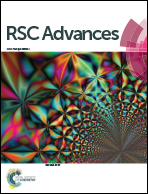Estimation of electrical parameters inside nanofiltration membranes in various electrolyte solutions by dielectric spectroscopy analysis†
Abstract
This work reports the dielectric analysis of three kinds of nanofiltration membranes (NF90, NF- and NF270) in eight electrolyte solutions. The high-frequency relaxation was analyzed theoretically and the relative permittivity and conductivity of the wet-membranes were calculated. Porosity of these membranes and ion solvation energy barrier were calculated using the relative permittivity of the wet-membrane. By combining the conductivity ratio of membrane and solution, κm/κw, with the TMS model, the volumetric charge density of the membranes was estimated. The concentration expressions of co- and counter-ions in the membranes were deduced based on the Donnan exclusion theory. The wet membrane's relative permittivity rather than the dry one was used in all of the calculations, so the results are very close to the practical separation process. Furthermore, the influencing factors on the ion permeability for three types of NF membranes were discussed by considering the ion concentrations inside the membranes, ion solvation energy barrier and the surface charge density on the pore-wall.


 Please wait while we load your content...
Please wait while we load your content...